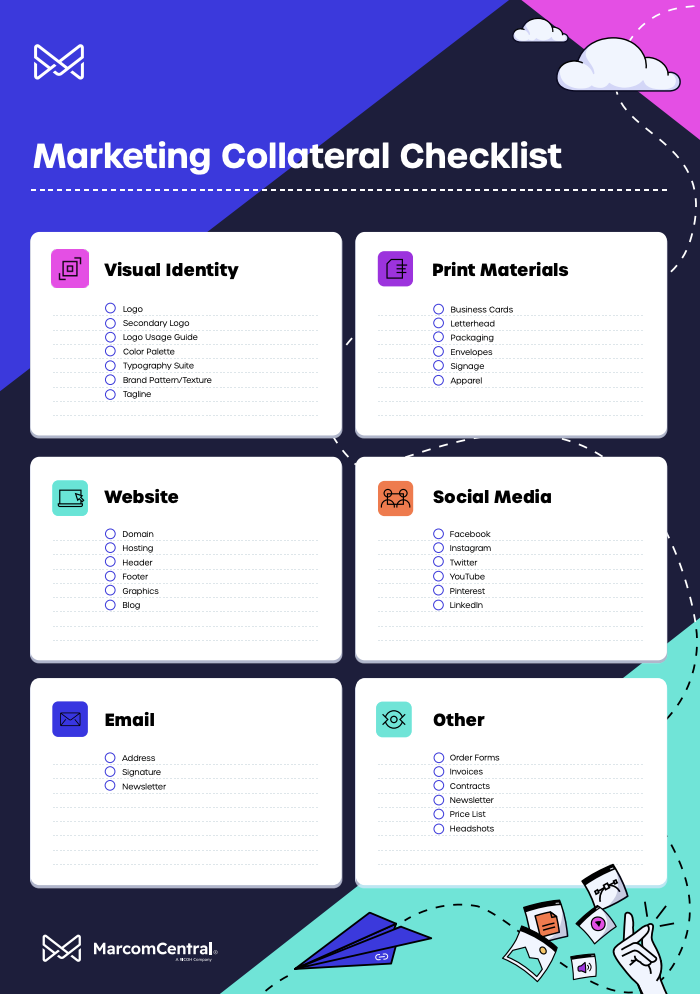- What Is Brand Consistency, and Why Is It Important?
- Benefits of Brand Consistency
- How to Ensure Brand Consistency in The Long Run
- 5 Questions to Assess Your Company's Brand Consistency
- Achieve Brand Consistency with MarcomCentral
Get news, updates, and insights delivered straight to your inbox.
Brand Consistency: Why It Is Important For Building Trust and How to Maintain It

A brand is not a single product or service a company provides. Rather, it’s the positive emotions or impressions a customer experiences when they come into contact with that company. Simply put, your brand’s voice is a collective of your organization’s core values, and it often plays a key role in the success of your business. Not only does brand identity help shape the narrative around your company, but it also can entice your target audience to come back for repeat business. Just as establishing a brand image for your company is important, so is brand consistency.
Identifying your brand and maintaining consistency both sound great, but how is it done? Learn more about consistent brand identity and why it’s so critical to your branding efforts and your company’s growth and success.
What Is Brand Consistency, and Why Is It Important?
Studies show almost 65% of a company’s business comes from repeat customers, and 82% of companies agree that retention is cheaper than acquisition. To accumulate lifelong customers, companies need to build trust. This can be accomplished through brand awareness and brand consistency. The more consistent your brand, the more brand recognition you have with consumers, providing a feeling of reliability.
Brand consistency is how an organization delivers messages aligned with its core values, brand promise, customer experience, and brand identity elements. It ensures that your brand is easily recognizable across all marketing channels and touchpoints. Doing so helps to unify the image and message you wish current and potential customers to see.
Benefits of Brand Consistency
How brand elements make a customer feel plays a big part in their purchasing decisions, whether or not they’re aware of it. According to Harvard professor Gerald Zaltman, 95% of purchasing decisions are subconscious, showing that purchasing is more of an emotional decision than a practical one.
To better meet the needs of your customers, you must build an identifiable brand that can set you apart from your competition. Once you do, you will see noticeable benefits, such as:
Makes You Memorable
Some of the most recognizable and successful brand names are iconic because of their consistency. They don’t deviate from their mission and vision, making them very memorable in the eyes of their customers.
If your brand is inconsistent, you run the risk of confusing your target audience. You take control out of your own hands and force your customer base to do the hard work of keeping track of your image. With strong brand consistency, you become more memorable, allowing your customers to recognize your brand values much more efficiently.
Fosters Relationships with Clientele
Customer trust is the catalyst of any relationship in the world of business. 67% of customers say they’ll only continue buying products from a brand if they trust the company behind them, according to the Edelman Trust Barometer. Building that trust takes consistency on the part of the company. Presenting the same values in the same tone of voice to every customer at every step of their experience develops a reliable brand personality.
Better for Business
Because individuals are more likely to buy from a brand they trust, it should come as no surprise that maintaining brand consistency is good for business. Research shows that, on average, consistency increased revenue by 23%.
Today, there are more platforms than ever for consumers to share their experiences with a company. Social media platforms make it easy for customers to share their feelings and promote products or services to friends, family members, and colleagues.
This type of exposure can benefit businesses by increasing website traffic and generating new leads and revenue. However, it’s only beneficial with consistent branding. If a person isn’t met with the same great brand messaging their friends raved about, they are quick to create social media posts to let others know about it.
How to Ensure Brand Consistency in The Long Run
Given how beneficial brand consistency can be to a company, brand managers, marketing managers, CMOs, and others should take steps to ensure consistency. Ways this can be accomplished include:
Outline Clear Expectations with Branding Guidelines
Written and visual brand standards matter! They tell your employees (or external vendors) how to make decisions while staying on-brand. Establish your expectations first regarding the use of images, logos, tone, fonts, word choice, color schemes, visual elements, and more.
Additionally, branding guidelines are what dictate how everyone in an organization should communicate the brand to the world. Those guidelines should cover elements both visual (i.e. logo, typeface, color palette, fonts, photography) and narrative (tone, POV). These elements should always be reflected in collateral that’s meant to showcase and speak for a company, such as a brand’s story, buyer personas, and more.

FREE MARKETING COLLATERAL CHECKLIST
Download our visual checklist to ensure your marketing assets are on-brand and ready to go.
Download the Free Checklist
One way to help encourage the marketing team is to facilitate the use of brand guidelines by creating a digital asset and brand portal that employees across the organization can access. Keeping a current copy of the brand style guide within this portal will ensure that everyone in the company has always-on access to the current branding guidelines, even as market changes occur.
Establish a Centralized Platform
Make approved brand materials easily accessible for everyone across your organization using a centralized brand platform. Rather than relying on version control approaches through email, host assets in a centralized Marketing Asset Management tool.
Gauge Implementation
Brand managers within large organizations are responsible for ensuring their marketing efforts are working. That can be difficult to measure, as brand consistency is hard to pinpoint until there’s an infraction or improper use of brand materials.
Instead, measure the adoption of your centralized brand management software. By tracking what’s downloaded, customized, and requested, brand managers can measure their effectiveness by user growth over time and site traffic. This practice also helps them better understand the needs of the internal organization and focus more on what’s working.
Unite Visual Elements
A key branding strategy for maintaining consistency lies within its visual elements. Make sure that your visual brand is coherent across all marketing materials and is in line with the branding style guide.
Take Dropbox, for example. The cloud-based file sharing platform ensures that every communication from email messages to banner ads features their instantly recognizable logo. By consistently adhering to a unified approach across every touch point, Dropbox has established an unmistakable and undeniable visual identity for itself that places it top of mind for consumers and grants it a competitive advantage.Additionally, you should ensure that all employees have access to the necessary visual elements.
An advanced brand asset management solution can be helpful in this scenario. For instance, brand management platform users have the ability to lock specific content fields on marketing assets to ensure their teams can customize assets while remaining compliant.
Support Internal Brand Efforts
Recognize that brand consistency is a company-wide effort. Encouraging employees to learn the brand values, brand message, and the story behind them helps organizations exude a more professional image to clients and customers.
For example, B2B software company Splunk conducted an exercise a few years ago to define, articulate, and share the brand internally to new hires in order to maintain the culture as they grew from a startup to a global organization. This enabled the business to scale to greater heights while ensuring their original narrative, mission statement, and culture remained in tact.
To help facilitate these internal efforts, an organization could designate a brand manager who will act as the gatekeeper for the company’s products and services. Brand managers can ensure that employees maintain awareness of consistent branding, use the right brand voice across all marketing efforts, and understand the dos and don’ts when it comes to brand guidelines.
Expedite Brand Evolution
As organizations navigate internal changes to reflect shifts in the market, evolution in branding is likely to follow. Companies and their products must change and adapt to reflect new market needs. When this happens, make sure to review these changes from a branding perspective as well, keeping consistency top-of-mind.
Keep in mind that the core brand values don’t necessarily have to shift. Instead, changes can occur in creative elements, such as logo design, fonts, and color palette. Take a company that produces hair care products, for example. In an effort to respond to the market’s desire for less plastic waste, they might change the packaging or style of their bottles to reduce the amount of plastic used or switch to recycled plastic.
Another way to look at it is to introduce a new color scheme that identifies your brand. The use of specific colors can evoke emotional responses from different target audiences. For example, conveying trustworthiness in a logo might mean you include colors like blue and white. Other various color schemes can evoke other emotions, such as authority, power, and excitement. This type of brand evolution not only provides an opportunity for growth but preserves brand consistency as well.
Prepare for Changes
Change is inevitable, so preparing for it in advance will set an organization up for success and create a less burdensome experience. A simple way to ensure branding remains consistent throughout various changes is to use brand asset management software. Enlisting the help of a brand asset platform helps organizations store all of their marketing assets and provide controlled access to employees 24/7.
5 Questions to Assess Your Company’s Brand Consistency
To understand whether or not brand consistency is a challenge – or rather an opportunity – at your organization, ask yourself these five questions:
- When was our last audit?
Depending on the age and size of your company, you likely have hundreds, if not thousands of pieces of sales and marketing materials being used. When was the last time you audited these materials to ensure old, out-of-date, non-compliant marketing materials were removed from circulation?
- Is our brand eroding?
Out-of-date or non-approved assets do more harm than good. Though they are often created under the best of intentions, these assets actually erode your brand equity. Typically they’re assembled by rogue employees who need a PowerPoint, poster, product sheet, or other materials – fast.
The more these employees get away with creating their own versions of marketing materials, the more your brand is exposed to risk of unprofessional or off-brand imagery, copy, company logo manipulation, and more.
Offer a dedicated area for brand-approved assets and resources to secure peace of mind that your brand is being represented in a consistent way.
- Are there non-approved vendors creating materials?
Vendors are an extension of your organization. Like employees who go rogue creating unapproved versions of brand materials, vendors who aren’t trained in brand standards or who aren’t equipped with access to the right brand materials can offer the same risk.
They bring no malicious intent (we hope) but rather simply need to be educated on the proper steps to ensure the materials they are using are on brand. Train them on an ongoing basis to ensure they follow brand standards and don’t inadvertently tarnish your brand experience for customers.
- Are team members using old materials?
After major brand updates, product launches, or a shift in messaging, it can be easy for members of the marketing team to miss the latest updates and think they have the most recent material, when they really do not. As brand strategy evolves, brand materials do as well. Each time you make updates, be sure to have internal communications about brand changes.
- Are non-marketers creating marketing?
Two words. Clip art.
As a marketer, you surely don’t expect your colleagues who are not in marketing to… do marketing. If they do start to create their own assets, they may think clip art is ok to represent your brand (as one example of a common offense). Discourage the practice by responding to the needs of the organization. Make it easy for your teams to create brand consistent flyers, brochures, posters, and more, under the brand guidelines you set.
Achieve Brand Consistency with MarcomCentral
Maintaining brand consistency successfully may be challenging, but the benefits are worth it. Don’t underestimate the importance of brand consistency, as it can lead to several growth opportunities for your company.
Organizations that believe their marketing strategies are failing to meet expectations can turn to Marcom for advanced solutions. We’re pleased to offer a brand management portal that helps deliver consistent messaging across every marketing channel, as well as proven brand guidelines. Doing so will help instill more trust in your customers and ultimately lead to more successful business endeavors.
We encourage you to view our case studies to see the benefits of using our platform for experiencing better brand consistency. Contact us today to learn more about our modern and efficient marketing tools that can help improve your marketing campaigns.
You might also like



